As a kid one of the things I always looked forward to during the summer was the local county 4-H Fair(local county/state fair organization in the US). I’d spend the year prior to the event working on various projects to enter into the 4-H Fair. None of these were fiber arts related though as I wasn’t quite into that yet. I had a lot of fun and I remember learning a lot. After I grew out of the age group for 4-H I had stopped entering in the fair, I had failed to realize they had adult division for entering all sorts of projects. This year marks my second year entering my fiber projects into the local fair. I find that it’s extremely rewarding not only to show off and be proud of the work I have accomplished but also to see the marks and commentary from the judges to help guide me in the right direction so I can learn what I need to improve. We are always our own worst critic and sometimes we are overly critical of what we have accomplished but at the same time without having outside input it can be hard to really grasp what it is that we need to do to continue to improve at our craft.
As our own worst critics entering your work in a public show can be intimidating. The thoughts of “is this really good enough to enter” may stream across your mind. Don’t listen to that! While it is true you should try to enter only the best of what all you have accomplished over the past year, don’t be too hard on yourself. We all must start somewhere, learn from experiences, and continue to grow. By entering, you also encourage others to do so as well. Some events are small and not very many people enter while other events have more extensive participation. The more people who participate the more they will inspire others to join in and at the same time the more they will challenge everyone to become better. If you have trouble figuring out what you want to enter don’t be afraid to seek out the advice of others whether it’s friends or members of your guild or spinning group.
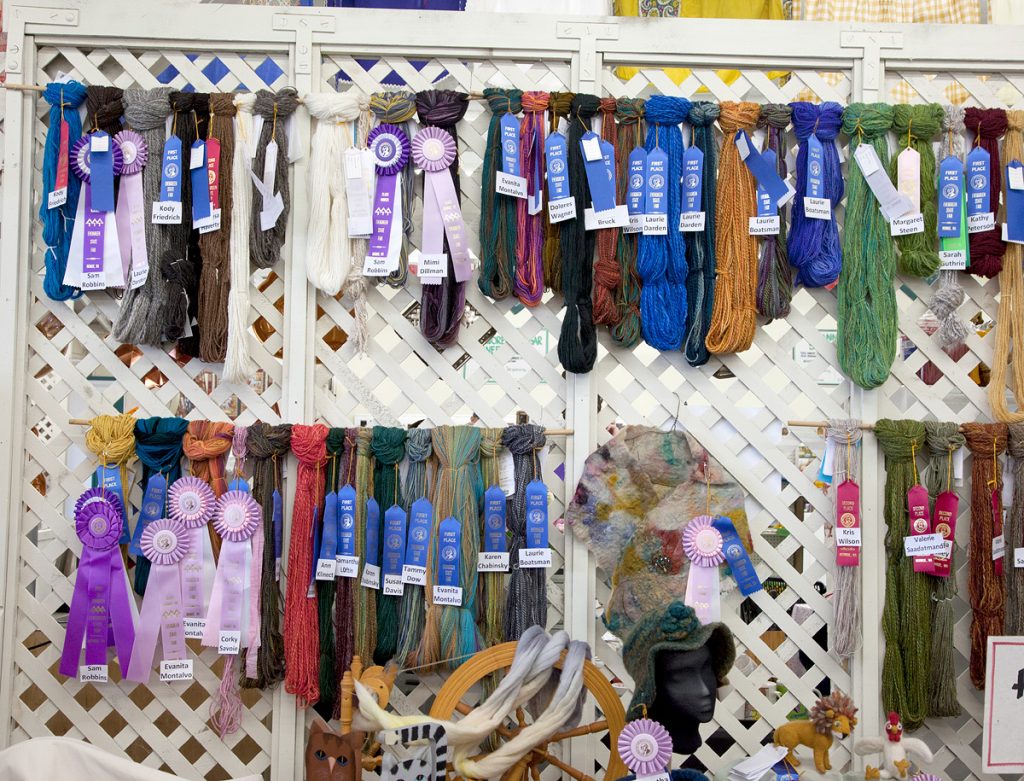
So what should you enter? You should enter what you feel is the best you have created for the past year(or whatever the allowed time frame is) and if possible you should make sure you enter in a variety of different sections/subsections. The sections available for entry will vary from event to event. For handspun they will often have sections divided into a multitude of subsections. For the state fair I attend they are divided by whether they are 100% a single type of fiber vs blended, natural vs dyed, as well as by plying type including Singles, Multi, and Novelty. For the categories for 100% single fiber they are subdivided by types of fiber so all cotton yarns will compete against cotton yarns for example. The Blended section is divided up by type of ply and whether it’s natural or dyed. They also include a section for yarns that are completely spindle spun. With all the subdivision of the sections it allows for a wide variety of different yarns as well as allows yarns to compete against other yarns that are more similar. The reasoning behind entering in a variety of different sections is so that you aren’t competing with yourself. It isn’t necessarily a bad thing to have a couple in the same section but it’s definitely better to try to be involved in several different sections if possible.
Preparing your items for the show is super important! The presentation of your yarn is key. There’s quite a few things to keep in mind. You’ll want to make sure your yarn is washed and you’ll want to skein your yarn again as often times after being washed a skein’s appearance is not at it’s best. I like to carefully wind my skeins on a skein winder so that my color progressions show clearly. I’m super big into gradients and how colors progress through a skein so this is just a personal preference.
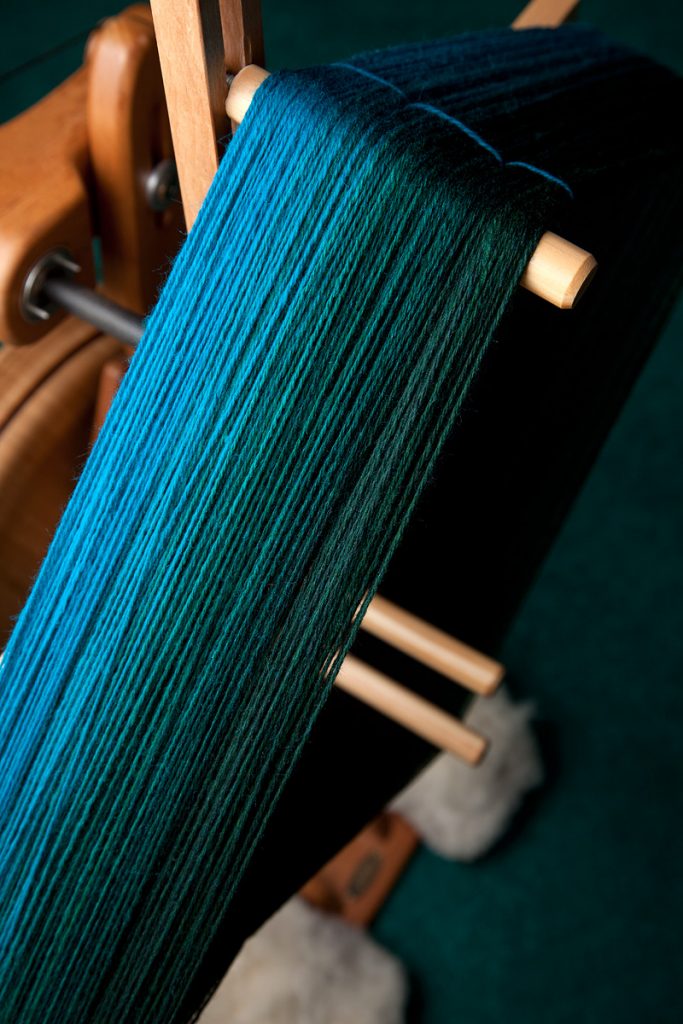
I often have my yarn a good 5-8 ft away from where I’m skeining when I originally skein my yarn prior to washing. This helps even out your twist across larger portions of your skein. If possible to do this when you reskein your yarn it can be helpful as well. Once you’ve skeined your yarn you’ll need to add your ties. The color of your ties is important, this is something I didn’t realize when entering into one of the local fiber festivals for the first time. I normally prefer white ties as they are easy to see when soaking my yarn but this is not acceptable for most skeins. For most events they’ll want your ties to coordinate with your yarn as much as possible so they blend in with your yarn and do not detract from it. For the skein above I used black ties.
For this skein I picked out yellow ties. You can either do figure eights or you can try the method in my video which I find works out the best.You’ll want to make sure your ends are not loose so using them as two of your ties is ideal. Often times your ends are not the prettiest so you’ll want to clip off any unwanted parts.
One of our local guilds NwRSA Area 2010 has classes on judging so to help grow the number of judges in our area to help with various events. During one of the classes they went over a different tying technique that may possibly be the best I’ve seen. I was kindly allowed to share this with you all. This technique was taught by Ann Klinect.
For some events they’ll have weight or yardage requirement. Our state fair requires a minimum of 1 ounce while Fiber Fusion requires a minimum of 25 yards. Some events may also get a bit cranky if your skein is too big. I’ve entered 8 oz skeins before and had some complaints that I should only enter 20-30 yards out of the whole skein to show. I’ve personally decided to disregard this complaint as I often deal with color transitions and don’t like to break my skeins into smaller ones. For some of my yarns I feel you can’t really fully appreciate it plus that also would mean for weaving in more ends and I think we all would like to weaving in the least amount of ends as possible. That being said it’s still wise to keep to 8oz or less when entering unless you’ve got some super monster bulky yarn of awesomness!
You’ll want to make sure you twist your yarn into a hank to ensure it stays nice on its journey to the fair. The judges will untwist the hank and give it a thorough look over after which they may place it back in hank form or other methods for show display.
More than likely you’ll have to write up some information for a 3by5 card that will be attached to the entry. This is information that the judge will see along with your work. For when I entered in the Evergreen State Fair they asked for the following.
- Fiber Content(if a blend, give the percent of fiber)
- Type of ply – single or multiple
- The intended end use of the yarn (be specific – example: knitted Guernsey or woven blanket)
- If hand-dyed by the exhibitor, give the type of dye used (natural or chemical and name/brand of dye.
For fiber content I also list the dyer to clarify that I did not dye the wool. For type of ply I like to indicate whether it was spindle or wheel spun/plied. I also indicate the type of ply such as traditional three ply vs Navajo ply. The third one, intended use is always a tricky one for me as sometimes my yarn is just yarn and I’m not quite sure what it wants to be when it grows up. For three of the yarns below I’ve got a strong feeling they want to be knitted shawls when they grow up and the middle yarn is definitely going to be a pair of knitted socks. The method of the creation of the end product is also important as for example knitting and weaving require different types of yarn.

For Fiber Fusion they went a bit more in depth with their questions
- Fiber Content
- Statement of intended use
- Preparations and techniques used in its creation
- Supply a fiber sample to demonstrate content(not a requirement but helpful)
The burning question.. So how do they judge your work?!?! Not all fairs judge in the same manner and some fairs aren’t as fortunate to have judges that as as well versed in the craft. Hopefully when you enter you’ll have someone who really knows the craft well as they can get you the best overall feedback. For the state fair I enter in they judge you as followed:
I. Preparation for Exhibit
Minimum weight: 1 ounce(disqualify if under minimum) 1pt
Properly tied & skeined 5pts
Properly blocked, if appropriate 4pts
General appearance of skein 6pts
II. Preparation of Fiber
Absence of vegetable matter and dirt 6pts
No visible neps or noils(unless part of the design) 6pts
Washed appropriately for type of yarn and intended purpose 6pts
(not sticky with grease or wax)
III. Technique
Consistent size overall(for consistent sett or gauge) 6pts
Control of twist – overall consistency 6pt
No obvious joins, breaks, knots etc 6pt
Soundness of yarn(for intended use), no shedding, pilling, drifting, thin, or weak areas 6pt
Appropriate amount of twist for fiber type(not over or under spun 6pts
Plying: Consistent and balanced 6pts
IV. Dyeing
Dye technique properly executed(no tie-dye marks, etc) 6pt
IV. Suitability of Yarn to Intended Use.
Hand 6pts
Appropriate fiber choice 6pts
Appropriate strength 6pts
Appropriate type and ply of yarn for intended use 6pt
Total points possible 100
Meanwhile at our local fiber festival Fiber Fusion they judge using the following:
General Overall Appearance: 10pts
Preparation for Exhibit: 20 pt
Clean, Properly Skeined and tied,
Of listed yardage and/or weight
Blocked if necessary
Suitability of Fiber to Yarn: 20pt
Amount of twist, Diameter of yarn
Technique: 30pt
Fiber Preparation, twist evenly executed, appropriate plying twist, diameter consistent throughout, structurally durable, designed yarns consistent, blending consistent
Suitability of Yarn to End Use: 20pt
Appropriate fiber choice, direction of twist, diameter of yarn, handle of yarn, appropriate # of plies.
I learned quite a bit this year from my four yarns I entered in the State Fair and I’m hoping to enter these yarns in a local fiber festival this weekend weather permitting. With what I’ve learned I might even be able to help improve some of these yarns before I enter them at the festival.

For this yarn my ends were loose so I got marked down a point. I had decided to use four normal ties instead of using the ends as ties. Next year I’ll be using the ends as two of the ties to avoid that or possible Ann Klinect’s method. It lost a point for “control of twist- overall consistency”. This one is a tricky one I think for a lot of us as handspun is not completely perfect. For Plying Consistency I lost a point as it was under plied in a few spots. I decided to run this yarn through on my wheel again to add a wee bit more twist to help alleviate that.
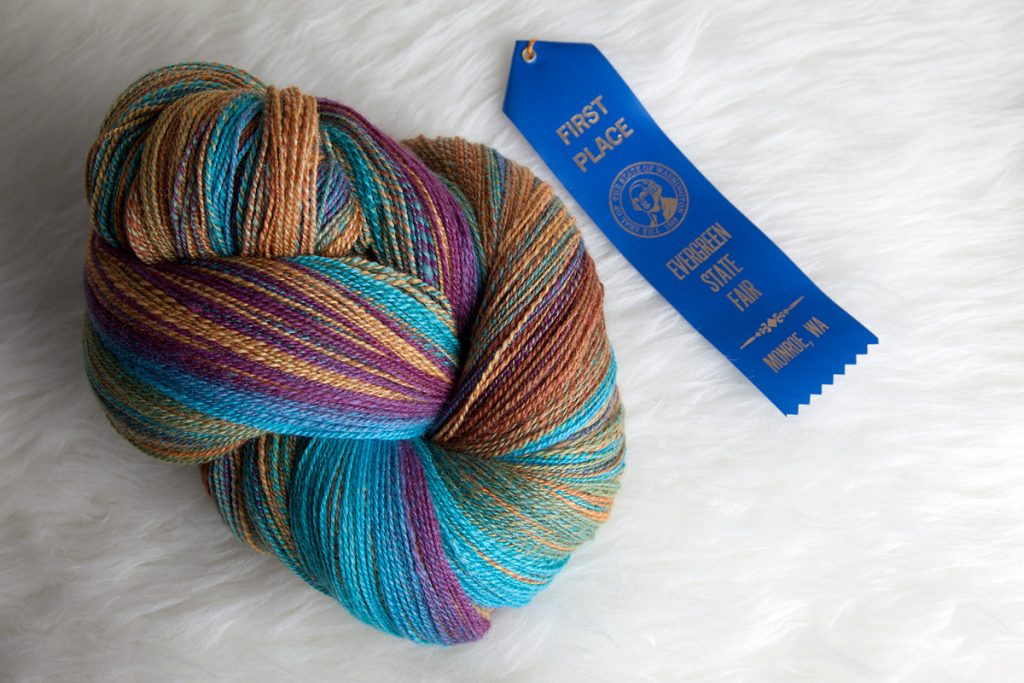
Tropical Sunset only lost a point for “Consistent size overall”. This is another tricky one I’ve found for me as well but I strive to become more consistent with each skein I create.
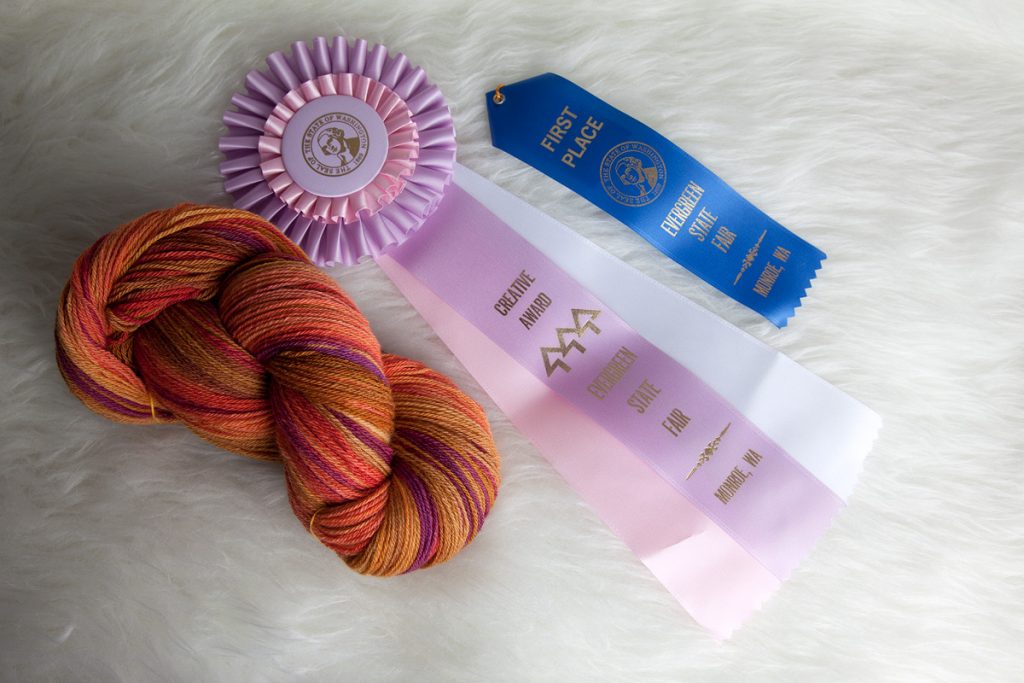
I lost a point on Heirloom Carrots for Plying Consistency, they felt it was a bit underplied. I do see this in some areas so as with Redwood Forest it will go back through the wheel to give it just a wee bit more twist.
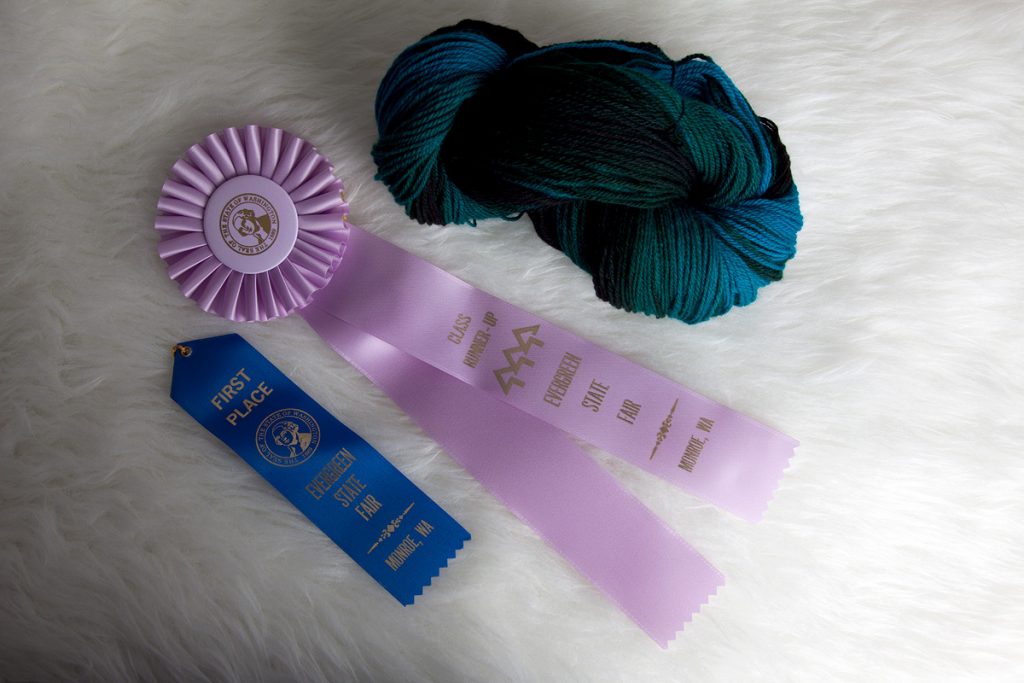
Blackbird also lost a point for being slightly underplied. I was a bit on the fence with this one as I thought I liked how it was.
I ended up running Blackbird, Heirloom Carrots, and Redwood Forest back through on my Aura at the lowest twist setting and highest pull in so I would only be adding a minor amount of twist. I ran Redwood Forest first as I knew adding more twist would make for a stronger sock yarn. I was pleasantly surprised by how much better it looked overall and I’m so thankful I took the judges advice. After seeing the improvements I did the same with the other two yarns. You can see the difference here. It’s subtle but overall it does look a lot better.
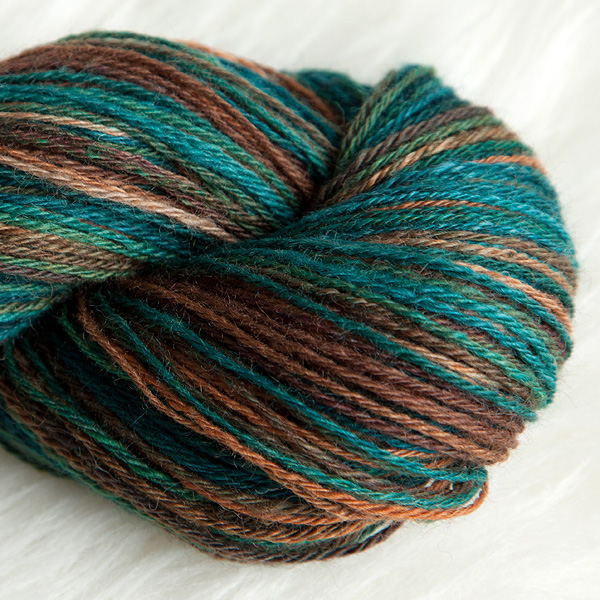
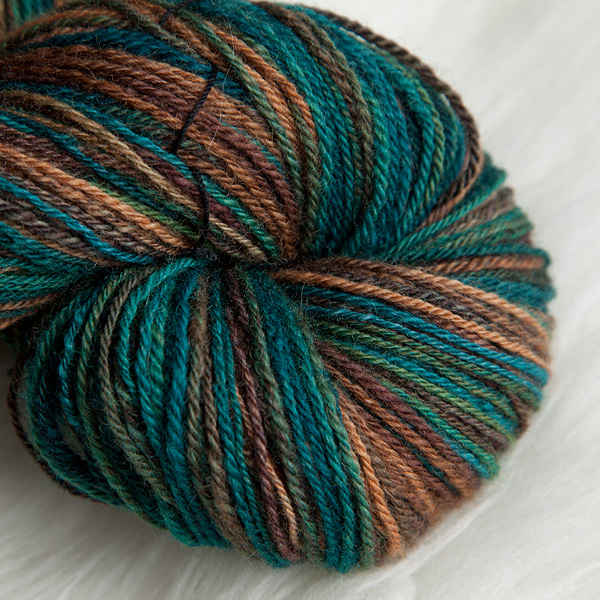
This year I learned that I need to be less afraid that I’m going to overply my yarn and I also need to continue to work on the consistency of my singles and plying. I know that handspun will never be 100% perfect as we are not machines but I can still strive to understand the faults within my work and what I’m able to do in the future to help make the best yarns possible. There was a lot of really amazing yarns entered this year. It makes for a great opportunity to be inspired by and to learn from each other. Don’t be too critical on yourself if you don’t do as well as you had hoped. Remember that for every mark you receive on your yarn it is something you can learn from to continue to grow. I hope you all will consider entering your yarns at any upcoming festivals and make sure to prepare for next year! Please remember don’t be afraid to put your work out there!
Evanita

Oh my gosh I love your tropical sunset yarn. Do you sell your yarns?